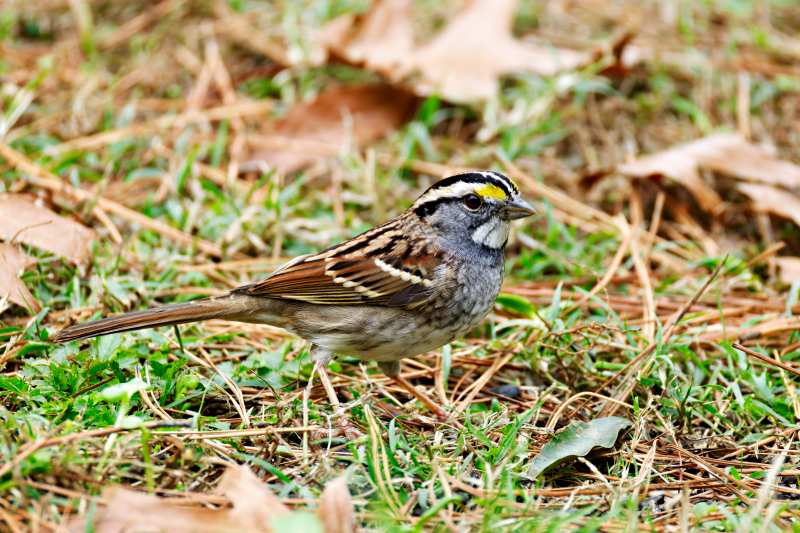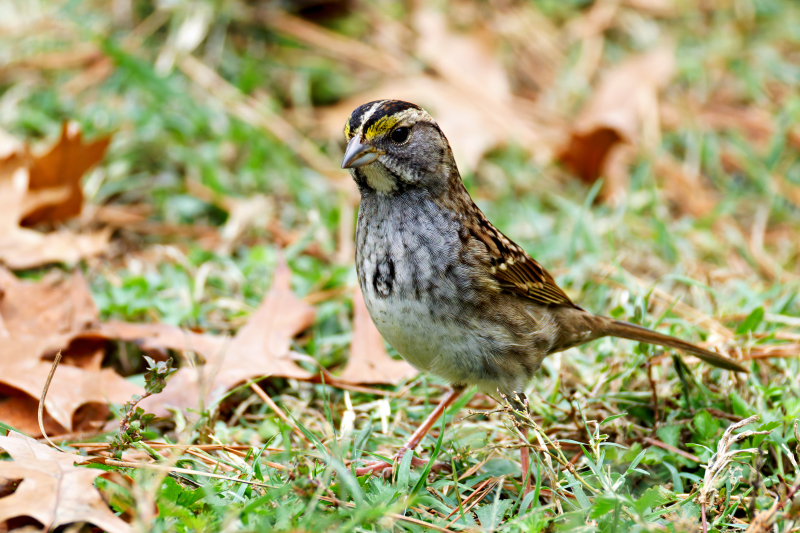Mia McPherson, a fellow wildlife photographer whose work you can explore at On the Wing Photography, suggested I pay closer attention when the White-throated Sparrows arrived in my yard. She told me these birds come in two distinct color morphs, thanks to a fascinating genetic phenomenon. She was right. I noticed subtle but clear differences in their markings. I decided to learn more, and today I’m sharing my photos and findings with you.
Color Morphs of White-throated Sparrows
White-throated Sparrows show two distinct color morphs: white-striped and tan-striped. These differences are not due to age or gender. Instead, they are linked to a unique genetic system involving a chromosomal “supergene.” This means that these two morphs are almost like two different personality types within the same species, which plays a key role in their behavior.
White-striped Morph
- Bright head with white and black stripes
- More aggressive
- Higher testosterone levels
- More vocal (they sing more often)
- Males often pursue extra-pair copulations
Tan-striped Morph
- Duller head with tan and brown stripes
- Less aggressive
- More nurturing, especially toward offspring
- Focused on providing for the family
You can see these differences in my photos here. One sparrow has a bright white and black head, while the other shows the more muted tan and brown pattern.


The Genetics Behind It
The reason behind these morphs is a supergene, which contains several linked genes inherited together. This supergene affects not just the color of the feathers but also the behavior of the birds. It’s like nature’s way of creating balance within the population.
Unique Mating Dynamics
White-throated Sparrows also have a distinct way of choosing mates. They almost always mate with the opposite morph. White-striped individuals pair with tan-striped ones, ensuring their young inherit a mix of traits from both types. This helps balance aggressive tendencies with nurturing behaviors, giving the next generation the best chance of survival.
This “opposites attract” strategy is critical for the sparrow population. Each pairing combines two different skill sets—one parent more aggressive in defending territory, the other more attentive to raising young. The result? A roughly even split of white-striped and tan-striped offspring, keeping both personality types in the population and maintaining genetic diversity.
Observations in My Yard
Since learning about this, I’ve been watching the White-throated Sparrows in my yard more closely. I’ve noticed that the tan-striped individuals seem more comfortable staying close to the ground, hopping around under bushes, while the white-striped ones often perch higher, watching (though I haven’t heard them singing yet). This fits with what I’ve learned—different strategies that balance each other out.
Getting these photos wasn’t easy. White-throated Sparrows prefer staying low, scratching through leaf litter for food.
Learn More About White-throated Sparrows
These sparrows are full of surprises, and their genetic system is unlike anything else you’ll see in your backyard. For more details, check out these resources:
- White-throated Sparrow – eBird
- For White-throated Sparrows, Opposites Attract – Northern Woodlands
- White-throated Sparrow Identification – All About Birds
Pay attention to the sparrows visiting your yard. You might spot these subtle differences too. Once you notice them, it’s hard not to see the unique roles each morph plays in the sparrow family.

very interesting, Steve